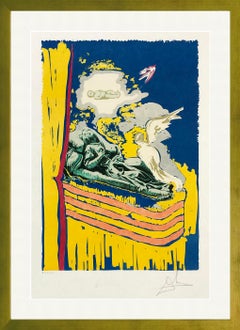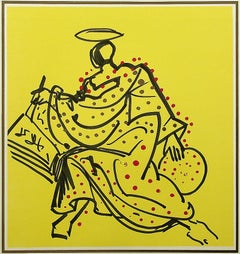Patrick Brissaud Art
to
2
Overall Width
to
Overall Height
to
2
2
2
2
1
1
1
1
2
2
8,232
2,807
1,650
1,318
2
Artist: Patrick Brissaud
Venice is a Woman and a World - Handsigned lithograph
By Patrick Brissaud
Located in Paris, IDF
Patrick BRISSAUD
Venice is a Woman and a World
Orignal lithograph
Handsigned in pencil
Numbered / 175 copies
On Arches Vellum 54 x 74 cm (c. 22 x 30 in)
Excellent condition
Category
Late 20th Century Surrealist Patrick Brissaud Art
Materials
Lithograph
Surrealist Body - Handsigned lithograph, 125 copies
By Patrick Brissaud
Located in Paris, IDF
Patrick BRISSAUD
Surrealist Body
Orignal lithograph
Handsigned in pencil
Numbered / 125 copies
On Arches Vellum 54 x 74 cm (c. 22 x 30 in)
Very good condition, paper slightly yello...
Category
Late 20th Century Surrealist Patrick Brissaud Art
Materials
Lithograph
Related Items
The Immaculate Conception (hand signed lithograph)
By Salvador Dalí
Located in Aventura, FL
Lithograph in colors on japon paper. Hand signed and numbered by Salvador Dali. Edition I LXIII/C. Sheet size 29.5 x 21.5 inches. Image size 23 x 15 inches. Frame size approx 34 x 24 inches.
Catalogue Raisonné: Field 79-12, pp. 185.
Artwork is in excellent condition. All reasonable offers will be considered.
About the Artist: Salvador Dalí (Spanish, 1904–1989) was a renowned Surrealist artist known for his enigmatic paintings of dreamscapes and religious themes. The Persistence of Memory (1931), arguably his best known work, visually manifests the strangeness of time, showing clocks melting in an idyllic landscape. “One day it will have to be officially admitted that what we have christened reality is an even greater illusion than the world of dreams,” he once reflected. Born Salvador Domingo Felipe Jacinto Dalí i Domènech on May 11, 1904 in Figueres, Spain, he displayed a great aptitude for the visual arts as a teenager. Three years after his first exhibition at the age of 14, he enrolled at the Academia de San Fernando in Madrid. At school, he emulated many contemporary styles but also the works of Johannes Vermeer and Diego Velázquez. During his visits to Paris in the late 1920s, he was introduced to the Surrealist movement by René Magritte and Joan Miró. Though the concept of Surrealism was new to him, Dalí was already well versed in the psychoanalytic theories of Sigmund Freud. Dabbling in various projects throughout his long career, in 1942 he published the book The Secret...
Category
1980s Surrealist Patrick Brissaud Art
Materials
Paper, Lithograph
$2,250 Sale Price
25% Off
H 29.5 in W 21.5 in
DALI Saint Mathew from Twelve Apostles suite signed & numbered Lithograph 1977
By Salvador Dalí
Located in Rancho Santa Fe, CA
Lithograph on Arches paper with embossing and gold foil by the Spanish surrealist artist Salvador Dali. From the 1977 Twelve Apostles Suite (sometimes ...
Category
1970s Surrealist Patrick Brissaud Art
Materials
Gold Leaf
$3,500
H 25.5 in W 18.8 in
"Departure #6" - 1976 Surrealist Lithograph on Paper
Located in Soquel, CA
"Departure #6" - 1976 Surrealist Lithograph on Paper
1976 surrealist lithograph on paper titled "Departure #6" by Jim Crabb (American, b. 1947). This piece resembles a surreal lands...
Category
1970s Surrealist Patrick Brissaud Art
Materials
Ink, Lithograph, Laid Paper
"Rabbit" - 1976 Surrealist Lithograph on Paper
Located in Soquel, CA
"Rabbit" - 1976 Surrealist Lithograph on Paper
1976 surrealist lithograph on paper titled "Rabbit" by Jim Crabb (American, b. 1947). This piece resembles a surreal landscape, with b...
Category
1970s Surrealist Patrick Brissaud Art
Materials
Ink, Laid Paper, Lithograph
original lithograph
By Max Ernst
Located in Henderson, NV
Medium: original lithograph. Catalogue reference Spies/Leppien 202. Published in 1971 by XXe Siecle. Sheet size: 12 1/4 x 9 3/8 inches (310 x 238 mm). Not signed.
Category
1970s Surrealist Patrick Brissaud Art
Materials
Lithograph
LA FOLLE AU PIMENT RAGEUR
By Joan Miró
Located in Aventura, FL
Hand signed and numbered lithograph in colors on Arches paper. Mourlot 1025. Published by Maeght Éditeur, Paris. Edition of 27/30. Artwork size 91.375 x 47.875 inches. Custom framed ...
Category
1970s Surrealist Patrick Brissaud Art
Materials
Paper, Lithograph
"Faded Jeans + Stuff" - Surrealist Colored Etching #10/20, 1976
Located in Soquel, CA
"Faded Jeans + Stuff" - Surrealist Colored Etching #10/20, 1976
Surrealist landscape with creatures by James C. Crabb (American, b. 1947). There is a low horizon, with objects that ...
Category
1970s Surrealist Patrick Brissaud Art
Materials
Laid Paper, Pigment, Lithograph
$850
H 16 in W 12 in D 0.25 in
La Mélodie Acide - 8 (Surrealism, Colorful, Modern, ~26% OFF LIMITED TIME ONLY)
By Joan Miró
Located in Kansas City, MO
Joan Miró
La Mélodie Acide - 8
Color lithograph
Year: 1980
Edition: 1500
Artist Dry Stamp lower right,
Annotated "H.C" (hors commerce) in pencil lower left
Size: 8.2 × 6.6 on 12.9 ...
Category
1980s Surrealist Patrick Brissaud Art
Materials
Lithograph
$588 Sale Price
26% Off
H 12.9 in W 9.9 in
"4 - U proof" - 1976 Surrealist Lithograph on Paper
Located in Soquel, CA
"4 - U proof" - 1976 Surrealist Lithograph on Paper
1976 surrealist lithograph on paper titled "4 - U proof" by Jim Crabb (American, b. 1947). This piece resembles a narrow, surreal...
Category
1970s Surrealist Patrick Brissaud Art
Materials
Ink, Laid Paper, Lithograph
DALI Saint Andrew from The Twelve Apostles suite (signed & numbered edition)
By Salvador Dalí
Located in Rancho Santa Fe, CA
Lithograph on Arches paper with embossing and gold foil by the Spanish surrealist artist Salvador Dali.
From the 1977 Twelve Apostles Suite (sometimes referred to as the Knights of the Roundtable Suite). Signed and numbered in pencil.
This image is sometimes referred to as "Visions of Camelot."
Edition Size: 350. Paper Size: 22.5 x 18.8 in.
Referenced in; The Official Catalog of the Graphic works of Salvador Dali" by Albert Field as 72-14 C.
Published by S. Wajntraub, P. Moore, A. Lancel and J. Carpentier, Paris.
Framed
Provenance: Martin Lawrence Gallery...
Category
1970s Surrealist Patrick Brissaud Art
Materials
Gold Leaf
$3,500
H 25.5 in W 18.8 in
"Sundays Garden" - 1975 Surrealist Lithograph on Paper
Located in Soquel, CA
"Sundays Garden" - 1975 Surrealist Lithograph on Paper
1975 surrealist lithograph on paper depicting ascending string like figures by Jim Crabb (American, b. 1947). The black and wh...
Category
1970s Surrealist Patrick Brissaud Art
Materials
Paper, Ink, Lithograph
"lost + found" - 1976 Surrealist Lithograph on Paper
Located in Soquel, CA
"lost + found" - 1976 Surrealist Lithograph on Paper
1976 surrealist lithograph on paper titled "lost + found" by Jim Crabb (American, b. 1947). This piece features an arachnid-like...
Category
1970s Surrealist Patrick Brissaud Art
Materials
Ink, Laid Paper, Lithograph
Previously Available Items
Egypt : Apparition of Toutankhamon - Handsigned lithograph, Ltd. 60 copies
By Patrick Brissaud
Located in Paris, IDF
Patrick BRISSAUD
Egypt : Apparition of Toutankhamon
Orignal lithograph
Handsigned in pencil
Numbered / 60 copies
On Japan paper 54 x 74 cm (c. 22 x 30 in)
Excellent condition
Category
Late 20th Century Surrealist Patrick Brissaud Art
Materials
Lithograph
Lightning King - Handsigned lithograph
By Patrick Brissaud
Located in Paris, IDF
Patrick BRISSAUD
Lightning King
Original lithograph
Handsigned in pencil
Numbered / 175 copies
On vellum 76 x 56 cm
Excellent condition
Category
Late 20th Century Surrealist Patrick Brissaud Art
Materials
Lithograph
Patrick Brissaud art for sale on 1stDibs.
Find a wide variety of authentic Patrick Brissaud art available for sale on 1stDibs. You can also browse by medium to find art by Patrick Brissaud in lithograph and more. Much of the original work by this artist or collective was created during the 20th century and is mostly associated with the Surrealist style. Not every interior allows for large Patrick Brissaud art, so small editions measuring 30 inches across are available. Customers who are interested in this artist might also find the work of Francis de Saint-Genies, Guelfo Bianchini, and André Masson. Patrick Brissaud art prices can differ depending upon medium, time period and other attributes. On 1stDibs, the price for these items starts at $216 and tops out at $216, while the average work can sell for $216.

